COIT20248 Term 1 2019 Assessment 1: Hospital Information System Report
VerifiedAdded on 2023/01/18
|15
|3249
|69
Report
AI Summary
This report provides a comprehensive analysis of a Hospital Information System (HIS), addressing various aspects of its development and implementation. It begins with an introduction outlining the objectives of the HIS, which aims to improve efficiency in information storage and management. The report then explores different systems development methodologies, recommending the Joint Application Development (JAD) method for its user-centric approach. It details both functional and non-functional system requirements, including patient identifiers, e-prescription capabilities, security, and usability. A cost-benefit analysis, including NPV and ROI calculations, demonstrates the project's financial feasibility. The report also includes a project schedule with a Gantt chart and work breakdown structure (WBS), followed by a discussion of system information requirement investigation techniques, including stakeholder analysis and communication plans. The report concludes with reflections on the project and references.
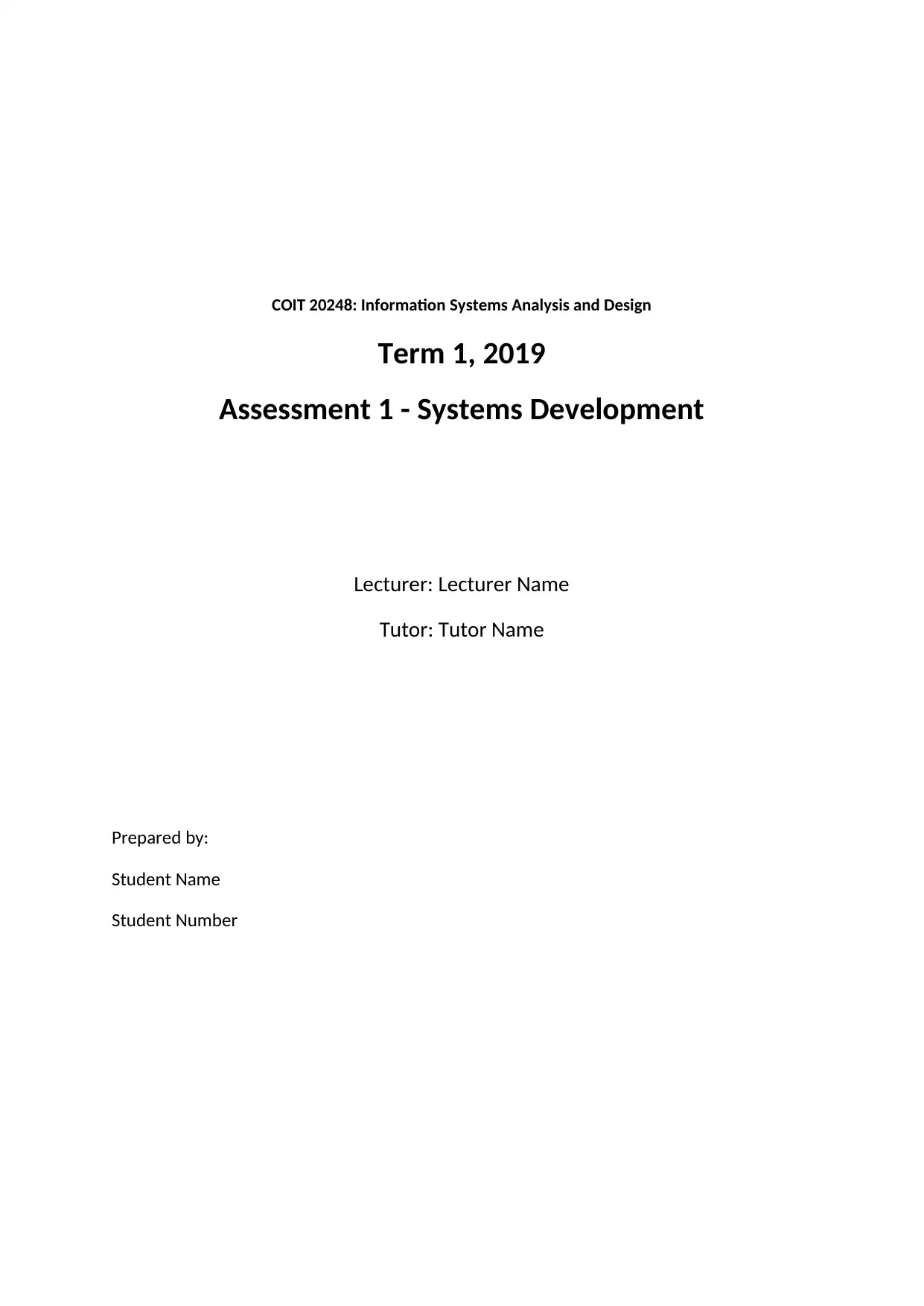
COIT 20248: Information Systems Analysis and Design
Term 1, 2019
Assessment 1 - Systems Development
Lecturer: Lecturer Name
Tutor: Tutor Name
Prepared by:
Student Name
Student Number
Term 1, 2019
Assessment 1 - Systems Development
Lecturer: Lecturer Name
Tutor: Tutor Name
Prepared by:
Student Name
Student Number
Paraphrase This Document
Need a fresh take? Get an instant paraphrase of this document with our AI Paraphraser
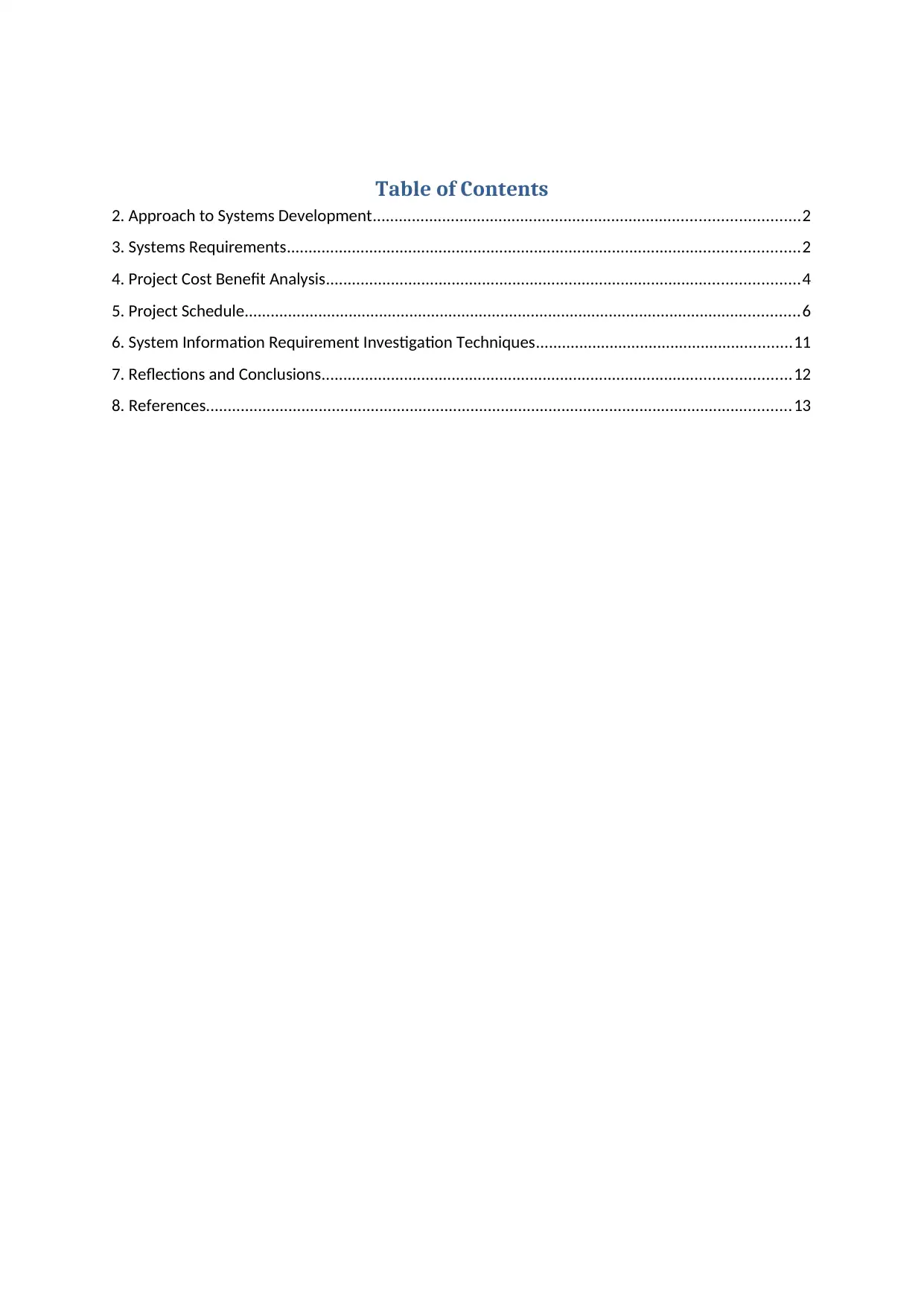
Table of Contents
2. Approach to Systems Development..................................................................................................2
3. Systems Requirements......................................................................................................................2
4. Project Cost Benefit Analysis.............................................................................................................4
5. Project Schedule................................................................................................................................6
6. System Information Requirement Investigation Techniques...........................................................11
7. Reflections and Conclusions............................................................................................................12
8. References.......................................................................................................................................13
2. Approach to Systems Development..................................................................................................2
3. Systems Requirements......................................................................................................................2
4. Project Cost Benefit Analysis.............................................................................................................4
5. Project Schedule................................................................................................................................6
6. System Information Requirement Investigation Techniques...........................................................11
7. Reflections and Conclusions............................................................................................................12
8. References.......................................................................................................................................13
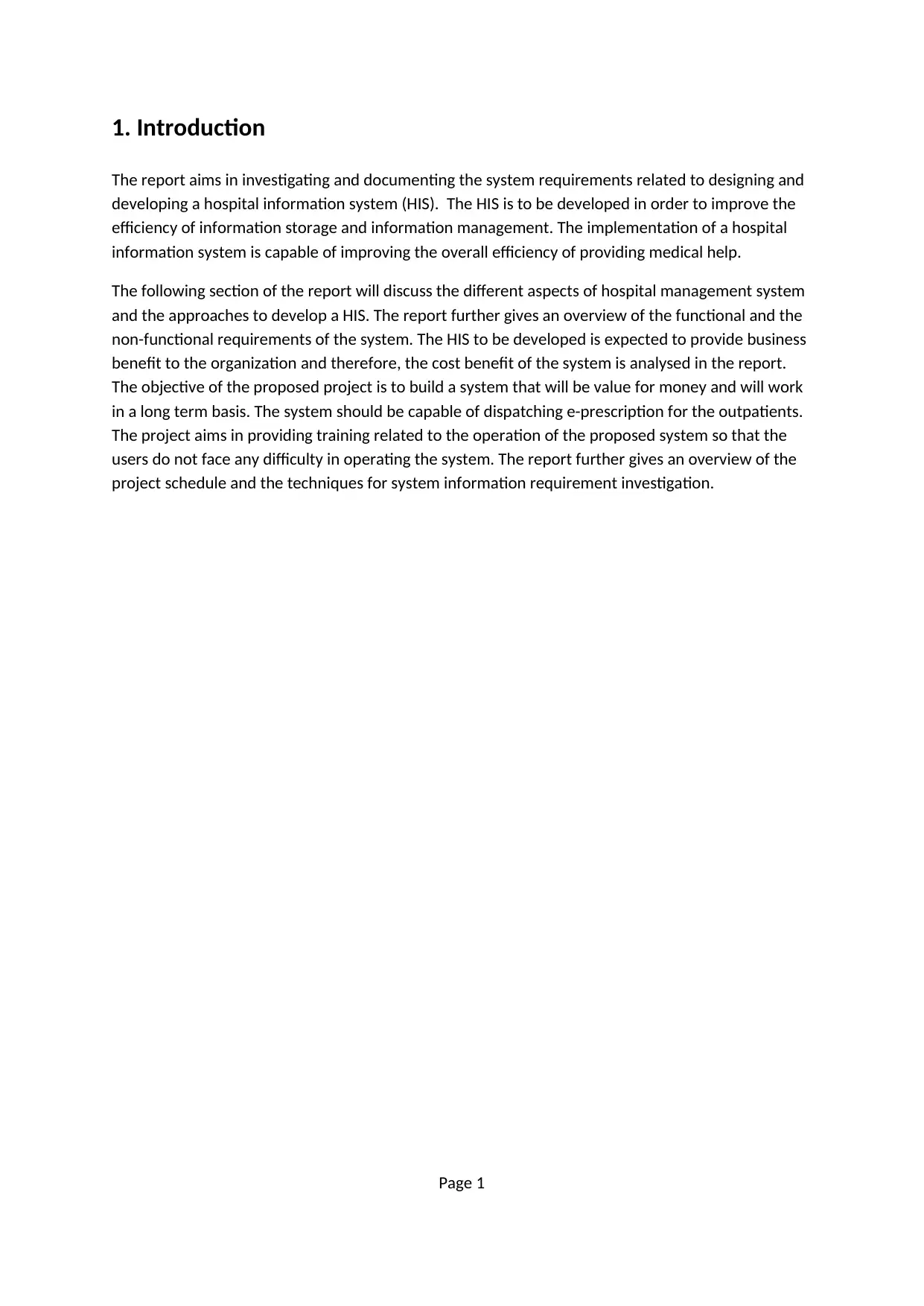
1. Introduction
The report aims in investigating and documenting the system requirements related to designing and
developing a hospital information system (HIS). The HIS is to be developed in order to improve the
efficiency of information storage and information management. The implementation of a hospital
information system is capable of improving the overall efficiency of providing medical help.
The following section of the report will discuss the different aspects of hospital management system
and the approaches to develop a HIS. The report further gives an overview of the functional and the
non-functional requirements of the system. The HIS to be developed is expected to provide business
benefit to the organization and therefore, the cost benefit of the system is analysed in the report.
The objective of the proposed project is to build a system that will be value for money and will work
in a long term basis. The system should be capable of dispatching e-prescription for the outpatients.
The project aims in providing training related to the operation of the proposed system so that the
users do not face any difficulty in operating the system. The report further gives an overview of the
project schedule and the techniques for system information requirement investigation.
Page 1
The report aims in investigating and documenting the system requirements related to designing and
developing a hospital information system (HIS). The HIS is to be developed in order to improve the
efficiency of information storage and information management. The implementation of a hospital
information system is capable of improving the overall efficiency of providing medical help.
The following section of the report will discuss the different aspects of hospital management system
and the approaches to develop a HIS. The report further gives an overview of the functional and the
non-functional requirements of the system. The HIS to be developed is expected to provide business
benefit to the organization and therefore, the cost benefit of the system is analysed in the report.
The objective of the proposed project is to build a system that will be value for money and will work
in a long term basis. The system should be capable of dispatching e-prescription for the outpatients.
The project aims in providing training related to the operation of the proposed system so that the
users do not face any difficulty in operating the system. The report further gives an overview of the
project schedule and the techniques for system information requirement investigation.
Page 1
⊘ This is a preview!⊘
Do you want full access?
Subscribe today to unlock all pages.

Trusted by 1+ million students worldwide
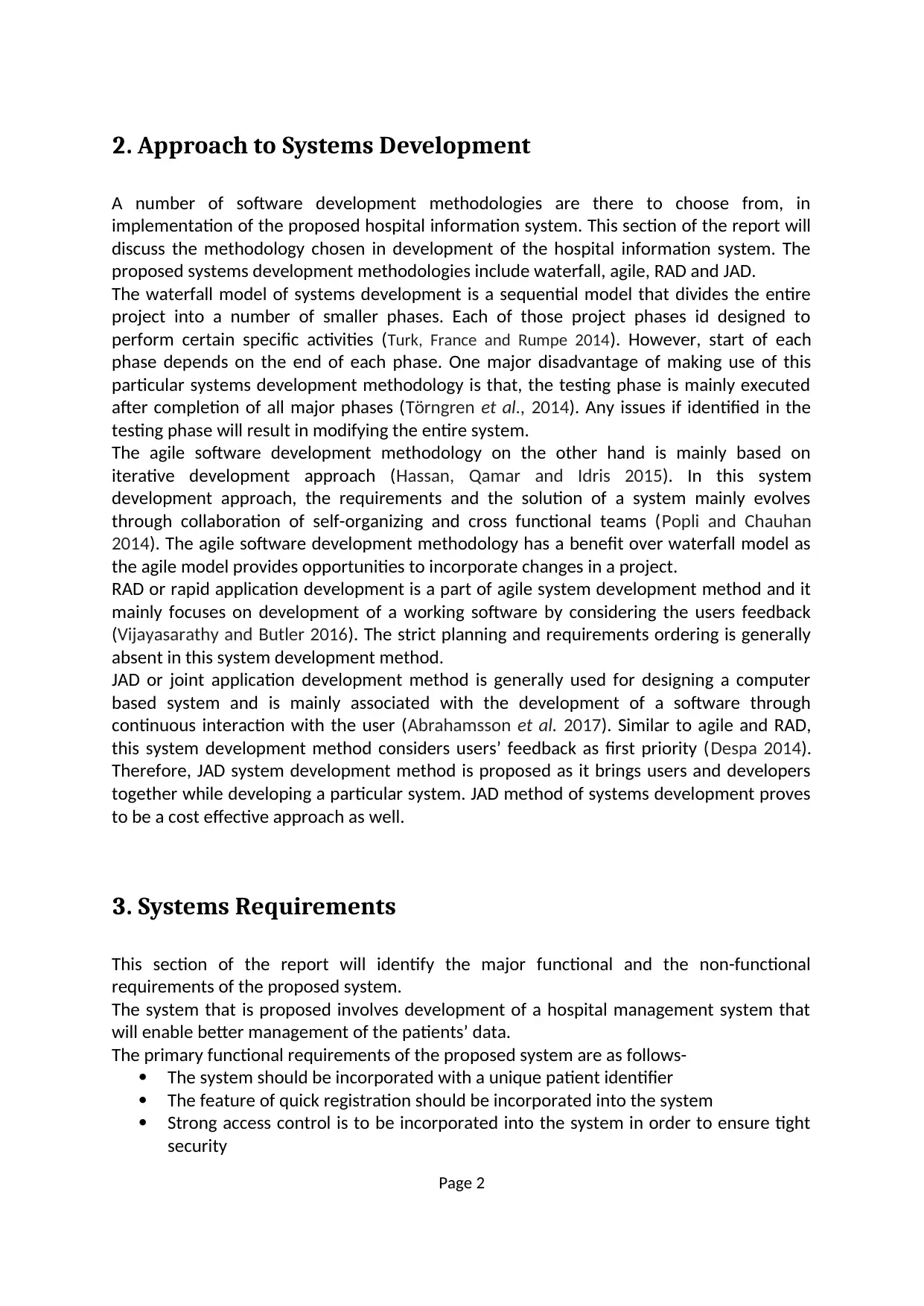
2. Approach to Systems Development
A number of software development methodologies are there to choose from, in
implementation of the proposed hospital information system. This section of the report will
discuss the methodology chosen in development of the hospital information system. The
proposed systems development methodologies include waterfall, agile, RAD and JAD.
The waterfall model of systems development is a sequential model that divides the entire
project into a number of smaller phases. Each of those project phases id designed to
perform certain specific activities (Turk, France and Rumpe 2014). However, start of each
phase depends on the end of each phase. One major disadvantage of making use of this
particular systems development methodology is that, the testing phase is mainly executed
after completion of all major phases (Törngren et al., 2014). Any issues if identified in the
testing phase will result in modifying the entire system.
The agile software development methodology on the other hand is mainly based on
iterative development approach (Hassan, Qamar and Idris 2015). In this system
development approach, the requirements and the solution of a system mainly evolves
through collaboration of self-organizing and cross functional teams (Popli and Chauhan
2014). The agile software development methodology has a benefit over waterfall model as
the agile model provides opportunities to incorporate changes in a project.
RAD or rapid application development is a part of agile system development method and it
mainly focuses on development of a working software by considering the users feedback
(Vijayasarathy and Butler 2016). The strict planning and requirements ordering is generally
absent in this system development method.
JAD or joint application development method is generally used for designing a computer
based system and is mainly associated with the development of a software through
continuous interaction with the user (Abrahamsson et al. 2017). Similar to agile and RAD,
this system development method considers users’ feedback as first priority (Despa 2014).
Therefore, JAD system development method is proposed as it brings users and developers
together while developing a particular system. JAD method of systems development proves
to be a cost effective approach as well.
3. Systems Requirements
This section of the report will identify the major functional and the non-functional
requirements of the proposed system.
The system that is proposed involves development of a hospital management system that
will enable better management of the patients’ data.
The primary functional requirements of the proposed system are as follows-
The system should be incorporated with a unique patient identifier
The feature of quick registration should be incorporated into the system
Strong access control is to be incorporated into the system in order to ensure tight
security
Page 2
A number of software development methodologies are there to choose from, in
implementation of the proposed hospital information system. This section of the report will
discuss the methodology chosen in development of the hospital information system. The
proposed systems development methodologies include waterfall, agile, RAD and JAD.
The waterfall model of systems development is a sequential model that divides the entire
project into a number of smaller phases. Each of those project phases id designed to
perform certain specific activities (Turk, France and Rumpe 2014). However, start of each
phase depends on the end of each phase. One major disadvantage of making use of this
particular systems development methodology is that, the testing phase is mainly executed
after completion of all major phases (Törngren et al., 2014). Any issues if identified in the
testing phase will result in modifying the entire system.
The agile software development methodology on the other hand is mainly based on
iterative development approach (Hassan, Qamar and Idris 2015). In this system
development approach, the requirements and the solution of a system mainly evolves
through collaboration of self-organizing and cross functional teams (Popli and Chauhan
2014). The agile software development methodology has a benefit over waterfall model as
the agile model provides opportunities to incorporate changes in a project.
RAD or rapid application development is a part of agile system development method and it
mainly focuses on development of a working software by considering the users feedback
(Vijayasarathy and Butler 2016). The strict planning and requirements ordering is generally
absent in this system development method.
JAD or joint application development method is generally used for designing a computer
based system and is mainly associated with the development of a software through
continuous interaction with the user (Abrahamsson et al. 2017). Similar to agile and RAD,
this system development method considers users’ feedback as first priority (Despa 2014).
Therefore, JAD system development method is proposed as it brings users and developers
together while developing a particular system. JAD method of systems development proves
to be a cost effective approach as well.
3. Systems Requirements
This section of the report will identify the major functional and the non-functional
requirements of the proposed system.
The system that is proposed involves development of a hospital management system that
will enable better management of the patients’ data.
The primary functional requirements of the proposed system are as follows-
The system should be incorporated with a unique patient identifier
The feature of quick registration should be incorporated into the system
Strong access control is to be incorporated into the system in order to ensure tight
security
Page 2
Paraphrase This Document
Need a fresh take? Get an instant paraphrase of this document with our AI Paraphraser
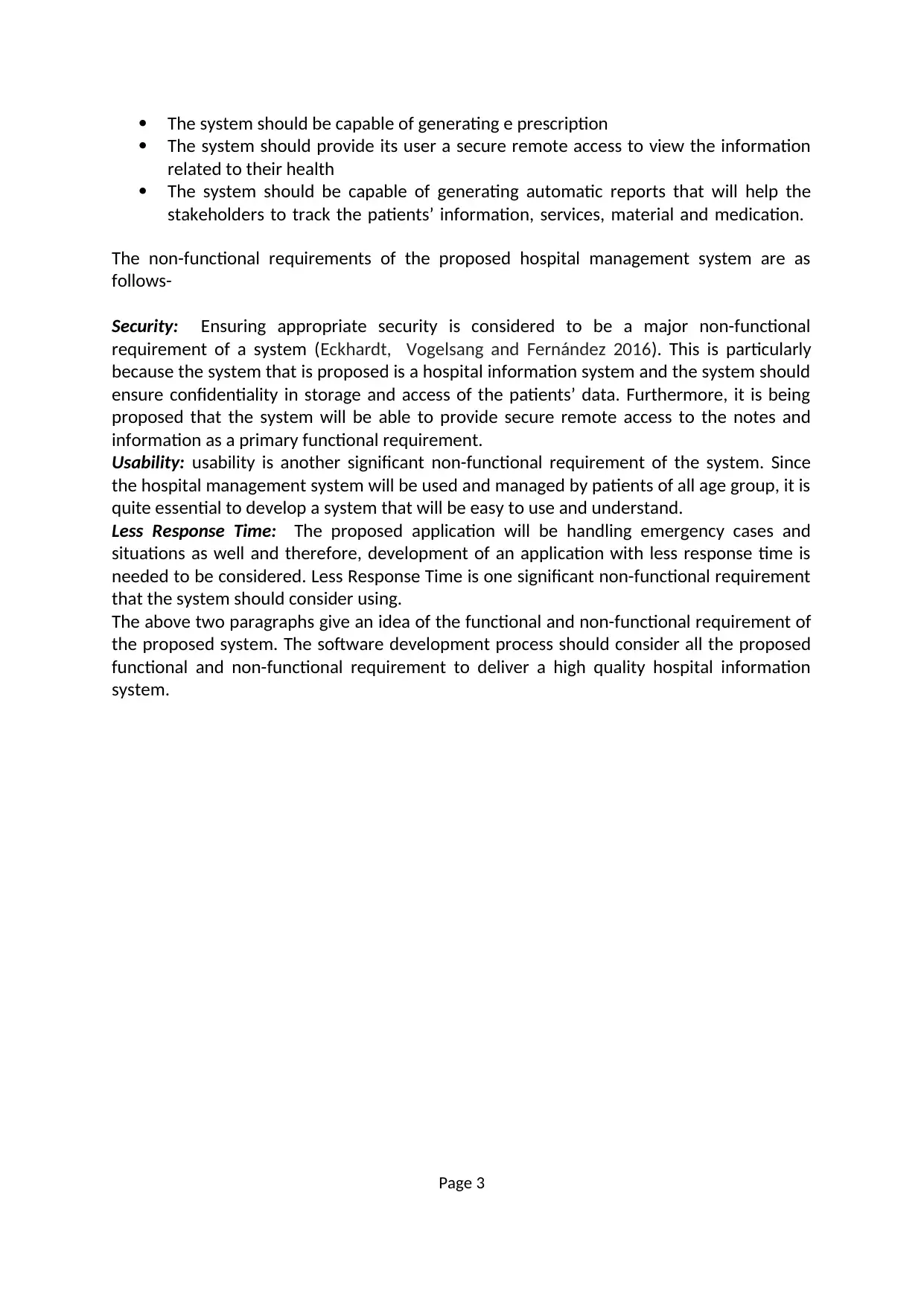
The system should be capable of generating e prescription
The system should provide its user a secure remote access to view the information
related to their health
The system should be capable of generating automatic reports that will help the
stakeholders to track the patients’ information, services, material and medication.
The non-functional requirements of the proposed hospital management system are as
follows-
Security: Ensuring appropriate security is considered to be a major non-functional
requirement of a system (Eckhardt, Vogelsang and Fernández 2016). This is particularly
because the system that is proposed is a hospital information system and the system should
ensure confidentiality in storage and access of the patients’ data. Furthermore, it is being
proposed that the system will be able to provide secure remote access to the notes and
information as a primary functional requirement.
Usability: usability is another significant non-functional requirement of the system. Since
the hospital management system will be used and managed by patients of all age group, it is
quite essential to develop a system that will be easy to use and understand.
Less Response Time: The proposed application will be handling emergency cases and
situations as well and therefore, development of an application with less response time is
needed to be considered. Less Response Time is one significant non-functional requirement
that the system should consider using.
The above two paragraphs give an idea of the functional and non-functional requirement of
the proposed system. The software development process should consider all the proposed
functional and non-functional requirement to deliver a high quality hospital information
system.
Page 3
The system should provide its user a secure remote access to view the information
related to their health
The system should be capable of generating automatic reports that will help the
stakeholders to track the patients’ information, services, material and medication.
The non-functional requirements of the proposed hospital management system are as
follows-
Security: Ensuring appropriate security is considered to be a major non-functional
requirement of a system (Eckhardt, Vogelsang and Fernández 2016). This is particularly
because the system that is proposed is a hospital information system and the system should
ensure confidentiality in storage and access of the patients’ data. Furthermore, it is being
proposed that the system will be able to provide secure remote access to the notes and
information as a primary functional requirement.
Usability: usability is another significant non-functional requirement of the system. Since
the hospital management system will be used and managed by patients of all age group, it is
quite essential to develop a system that will be easy to use and understand.
Less Response Time: The proposed application will be handling emergency cases and
situations as well and therefore, development of an application with less response time is
needed to be considered. Less Response Time is one significant non-functional requirement
that the system should consider using.
The above two paragraphs give an idea of the functional and non-functional requirement of
the proposed system. The software development process should consider all the proposed
functional and non-functional requirement to deliver a high quality hospital information
system.
Page 3
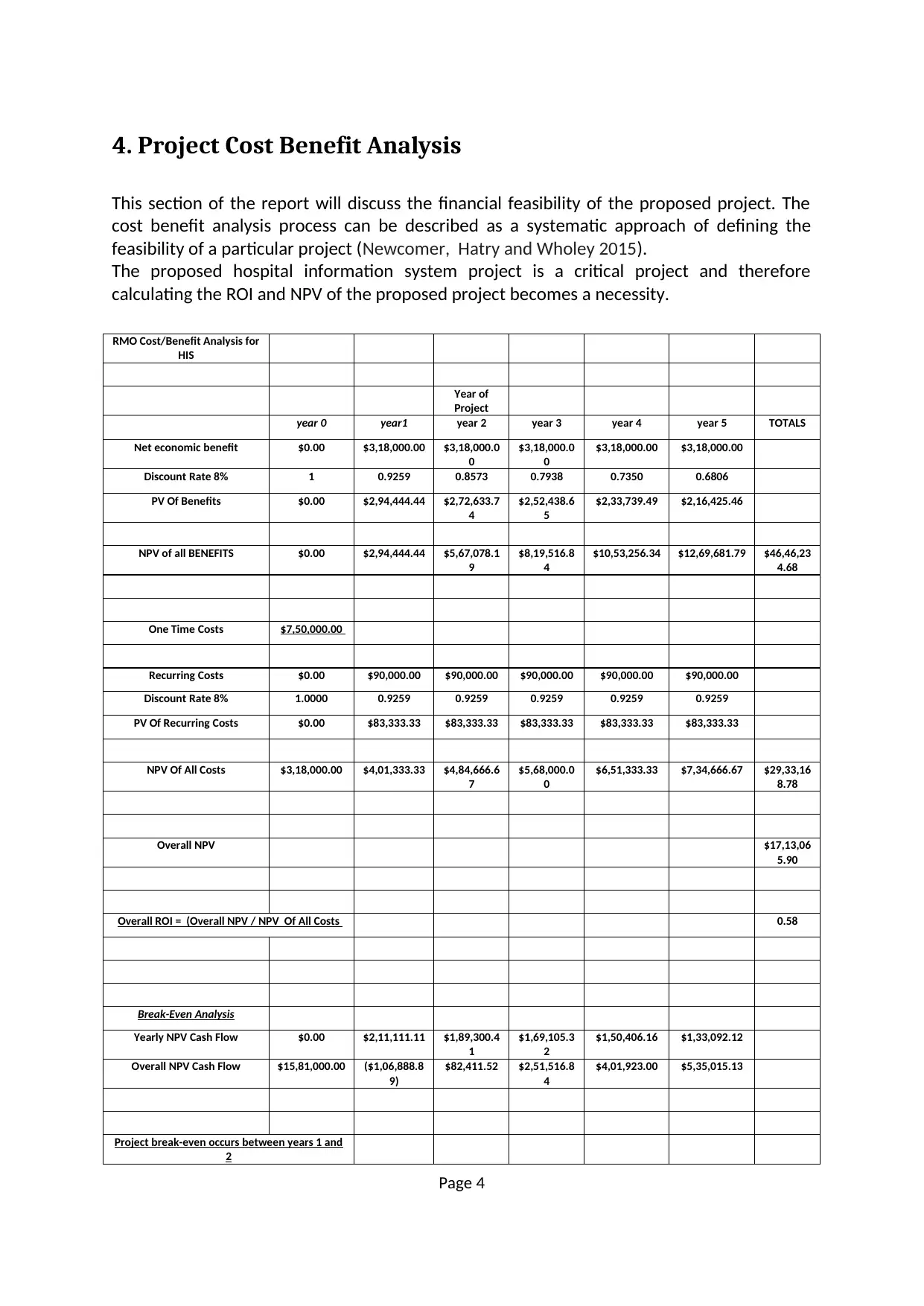
4. Project Cost Benefit Analysis
This section of the report will discuss the financial feasibility of the proposed project. The
cost benefit analysis process can be described as a systematic approach of defining the
feasibility of a particular project (Newcomer, Hatry and Wholey 2015).
The proposed hospital information system project is a critical project and therefore
calculating the ROI and NPV of the proposed project becomes a necessity.
RMO Cost/Benefit Analysis for
HIS
Year of
Project
year 0 year1 year 2 year 3 year 4 year 5 TOTALS
Net economic benefit $0.00 $3,18,000.00 $3,18,000.0
0
$3,18,000.0
0
$3,18,000.00 $3,18,000.00
Discount Rate 8% 1 0.9259 0.8573 0.7938 0.7350 0.6806
PV Of Benefits $0.00 $2,94,444.44 $2,72,633.7
4
$2,52,438.6
5
$2,33,739.49 $2,16,425.46
NPV of all BENEFITS $0.00 $2,94,444.44 $5,67,078.1
9
$8,19,516.8
4
$10,53,256.34 $12,69,681.79 $46,46,23
4.68
One Time Costs $7,50,000.00
Recurring Costs $0.00 $90,000.00 $90,000.00 $90,000.00 $90,000.00 $90,000.00
Discount Rate 8% 1.0000 0.9259 0.9259 0.9259 0.9259 0.9259
PV Of Recurring Costs $0.00 $83,333.33 $83,333.33 $83,333.33 $83,333.33 $83,333.33
NPV Of All Costs $3,18,000.00 $4,01,333.33 $4,84,666.6
7
$5,68,000.0
0
$6,51,333.33 $7,34,666.67 $29,33,16
8.78
Overall NPV $17,13,06
5.90
Overall ROI = (Overall NPV / NPV Of All Costs 0.58
Break-Even Analysis
Yearly NPV Cash Flow $0.00 $2,11,111.11 $1,89,300.4
1
$1,69,105.3
2
$1,50,406.16 $1,33,092.12
Overall NPV Cash Flow $15,81,000.00 ($1,06,888.8
9)
$82,411.52 $2,51,516.8
4
$4,01,923.00 $5,35,015.13
Project break-even occurs between years 1 and
2
Page 4
This section of the report will discuss the financial feasibility of the proposed project. The
cost benefit analysis process can be described as a systematic approach of defining the
feasibility of a particular project (Newcomer, Hatry and Wholey 2015).
The proposed hospital information system project is a critical project and therefore
calculating the ROI and NPV of the proposed project becomes a necessity.
RMO Cost/Benefit Analysis for
HIS
Year of
Project
year 0 year1 year 2 year 3 year 4 year 5 TOTALS
Net economic benefit $0.00 $3,18,000.00 $3,18,000.0
0
$3,18,000.0
0
$3,18,000.00 $3,18,000.00
Discount Rate 8% 1 0.9259 0.8573 0.7938 0.7350 0.6806
PV Of Benefits $0.00 $2,94,444.44 $2,72,633.7
4
$2,52,438.6
5
$2,33,739.49 $2,16,425.46
NPV of all BENEFITS $0.00 $2,94,444.44 $5,67,078.1
9
$8,19,516.8
4
$10,53,256.34 $12,69,681.79 $46,46,23
4.68
One Time Costs $7,50,000.00
Recurring Costs $0.00 $90,000.00 $90,000.00 $90,000.00 $90,000.00 $90,000.00
Discount Rate 8% 1.0000 0.9259 0.9259 0.9259 0.9259 0.9259
PV Of Recurring Costs $0.00 $83,333.33 $83,333.33 $83,333.33 $83,333.33 $83,333.33
NPV Of All Costs $3,18,000.00 $4,01,333.33 $4,84,666.6
7
$5,68,000.0
0
$6,51,333.33 $7,34,666.67 $29,33,16
8.78
Overall NPV $17,13,06
5.90
Overall ROI = (Overall NPV / NPV Of All Costs 0.58
Break-Even Analysis
Yearly NPV Cash Flow $0.00 $2,11,111.11 $1,89,300.4
1
$1,69,105.3
2
$1,50,406.16 $1,33,092.12
Overall NPV Cash Flow $15,81,000.00 ($1,06,888.8
9)
$82,411.52 $2,51,516.8
4
$4,01,923.00 $5,35,015.13
Project break-even occurs between years 1 and
2
Page 4
⊘ This is a preview!⊘
Do you want full access?
Subscribe today to unlock all pages.

Trusted by 1+ million students worldwide
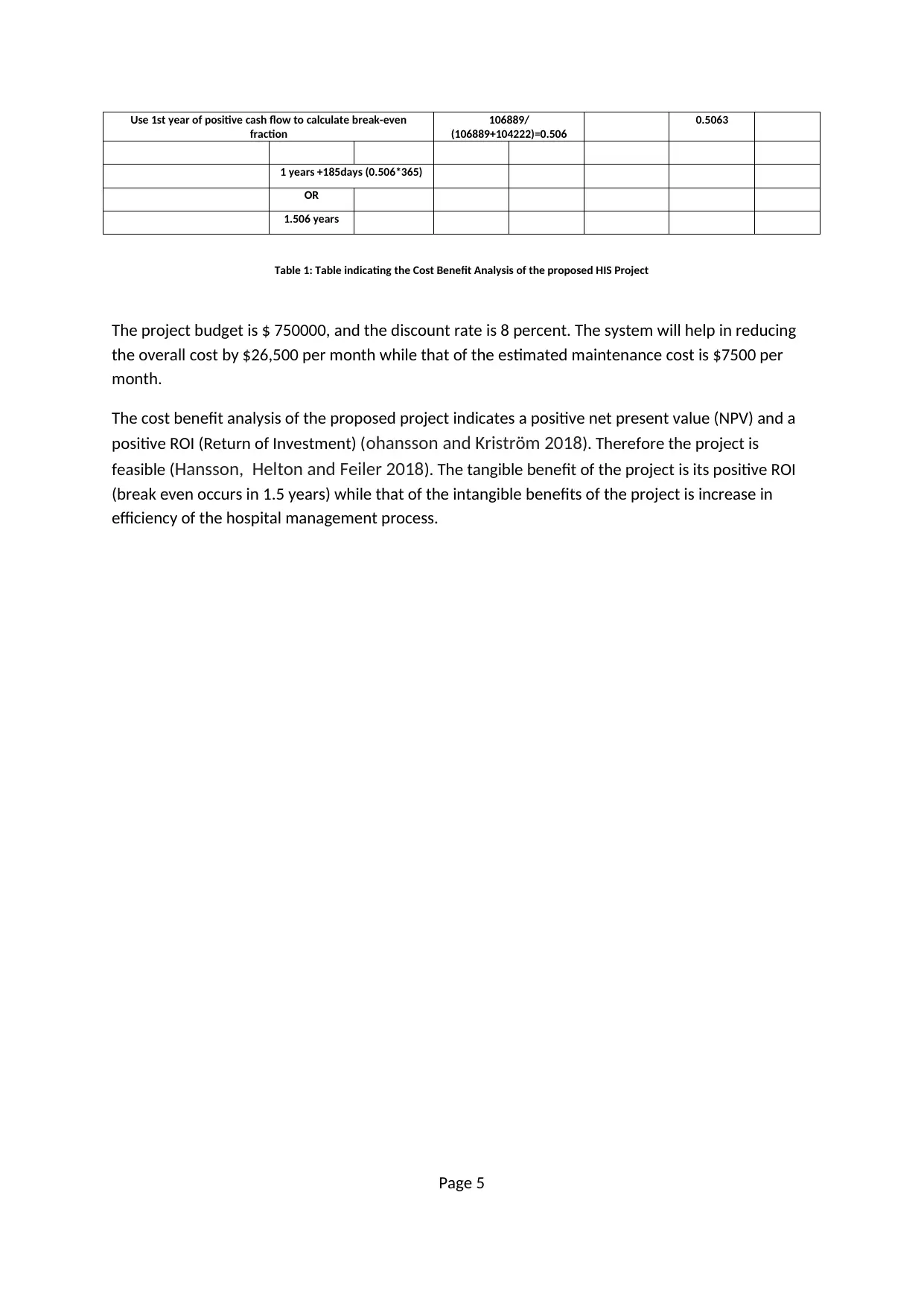
Use 1st year of positive cash flow to calculate break-even
fraction
106889/
(106889+104222)=0.506
0.5063
1 years +185days (0.506*365)
OR
1.506 years
Table 1: Table indicating the Cost Benefit Analysis of the proposed HIS Project
The project budget is $ 750000, and the discount rate is 8 percent. The system will help in reducing
the overall cost by $26,500 per month while that of the estimated maintenance cost is $7500 per
month.
The cost benefit analysis of the proposed project indicates a positive net present value (NPV) and a
positive ROI (Return of Investment) (ohansson and Kriström 2018). Therefore the project is
feasible (Hansson, Helton and Feiler 2018). The tangible benefit of the project is its positive ROI
(break even occurs in 1.5 years) while that of the intangible benefits of the project is increase in
efficiency of the hospital management process.
Page 5
fraction
106889/
(106889+104222)=0.506
0.5063
1 years +185days (0.506*365)
OR
1.506 years
Table 1: Table indicating the Cost Benefit Analysis of the proposed HIS Project
The project budget is $ 750000, and the discount rate is 8 percent. The system will help in reducing
the overall cost by $26,500 per month while that of the estimated maintenance cost is $7500 per
month.
The cost benefit analysis of the proposed project indicates a positive net present value (NPV) and a
positive ROI (Return of Investment) (ohansson and Kriström 2018). Therefore the project is
feasible (Hansson, Helton and Feiler 2018). The tangible benefit of the project is its positive ROI
(break even occurs in 1.5 years) while that of the intangible benefits of the project is increase in
efficiency of the hospital management process.
Page 5
Paraphrase This Document
Need a fresh take? Get an instant paraphrase of this document with our AI Paraphraser
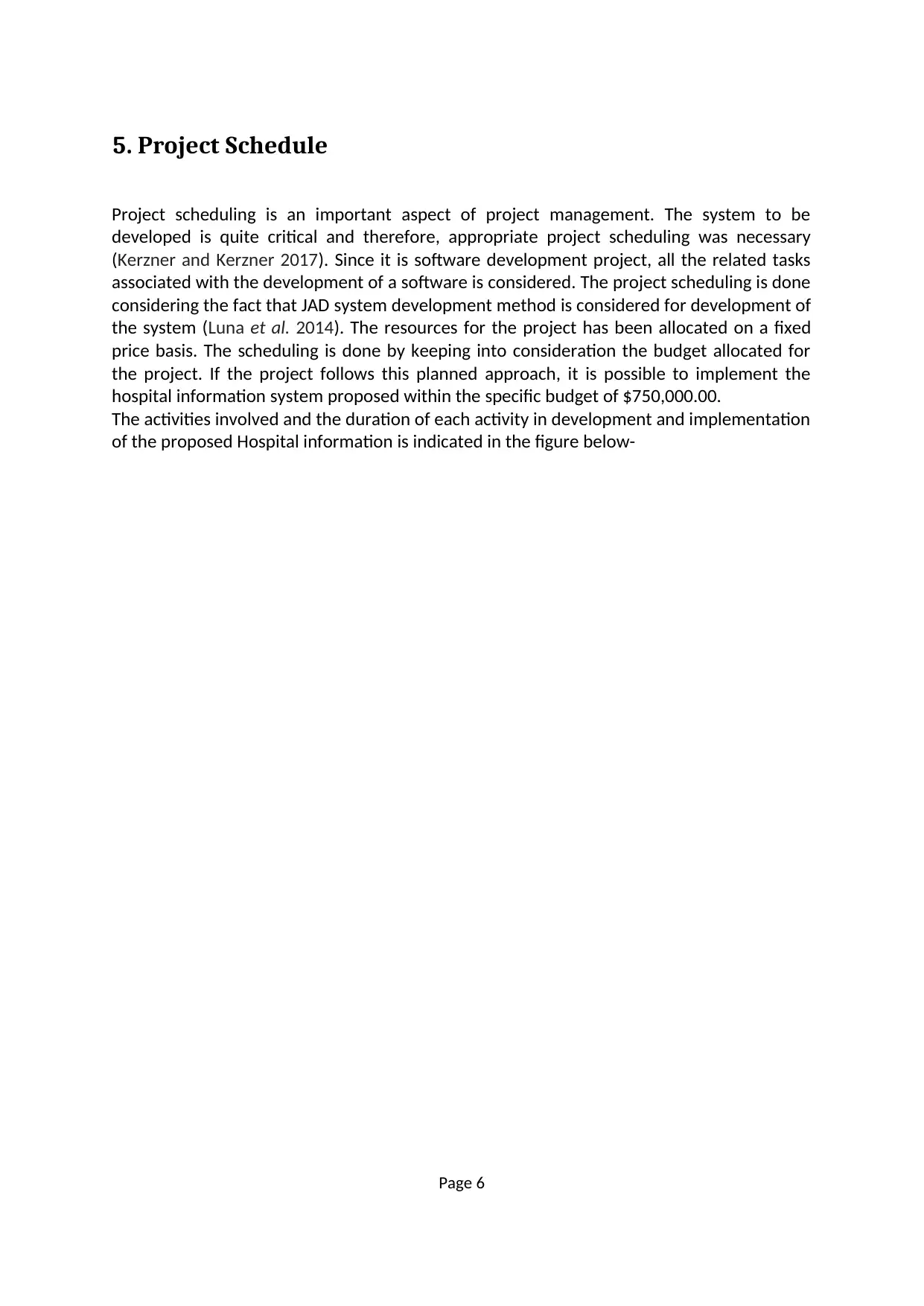
5. Project Schedule
Project scheduling is an important aspect of project management. The system to be
developed is quite critical and therefore, appropriate project scheduling was necessary
(Kerzner and Kerzner 2017). Since it is software development project, all the related tasks
associated with the development of a software is considered. The project scheduling is done
considering the fact that JAD system development method is considered for development of
the system (Luna et al. 2014). The resources for the project has been allocated on a fixed
price basis. The scheduling is done by keeping into consideration the budget allocated for
the project. If the project follows this planned approach, it is possible to implement the
hospital information system proposed within the specific budget of $750,000.00.
The activities involved and the duration of each activity in development and implementation
of the proposed Hospital information is indicated in the figure below-
Page 6
Project scheduling is an important aspect of project management. The system to be
developed is quite critical and therefore, appropriate project scheduling was necessary
(Kerzner and Kerzner 2017). Since it is software development project, all the related tasks
associated with the development of a software is considered. The project scheduling is done
considering the fact that JAD system development method is considered for development of
the system (Luna et al. 2014). The resources for the project has been allocated on a fixed
price basis. The scheduling is done by keeping into consideration the budget allocated for
the project. If the project follows this planned approach, it is possible to implement the
hospital information system proposed within the specific budget of $750,000.00.
The activities involved and the duration of each activity in development and implementation
of the proposed Hospital information is indicated in the figure below-
Page 6
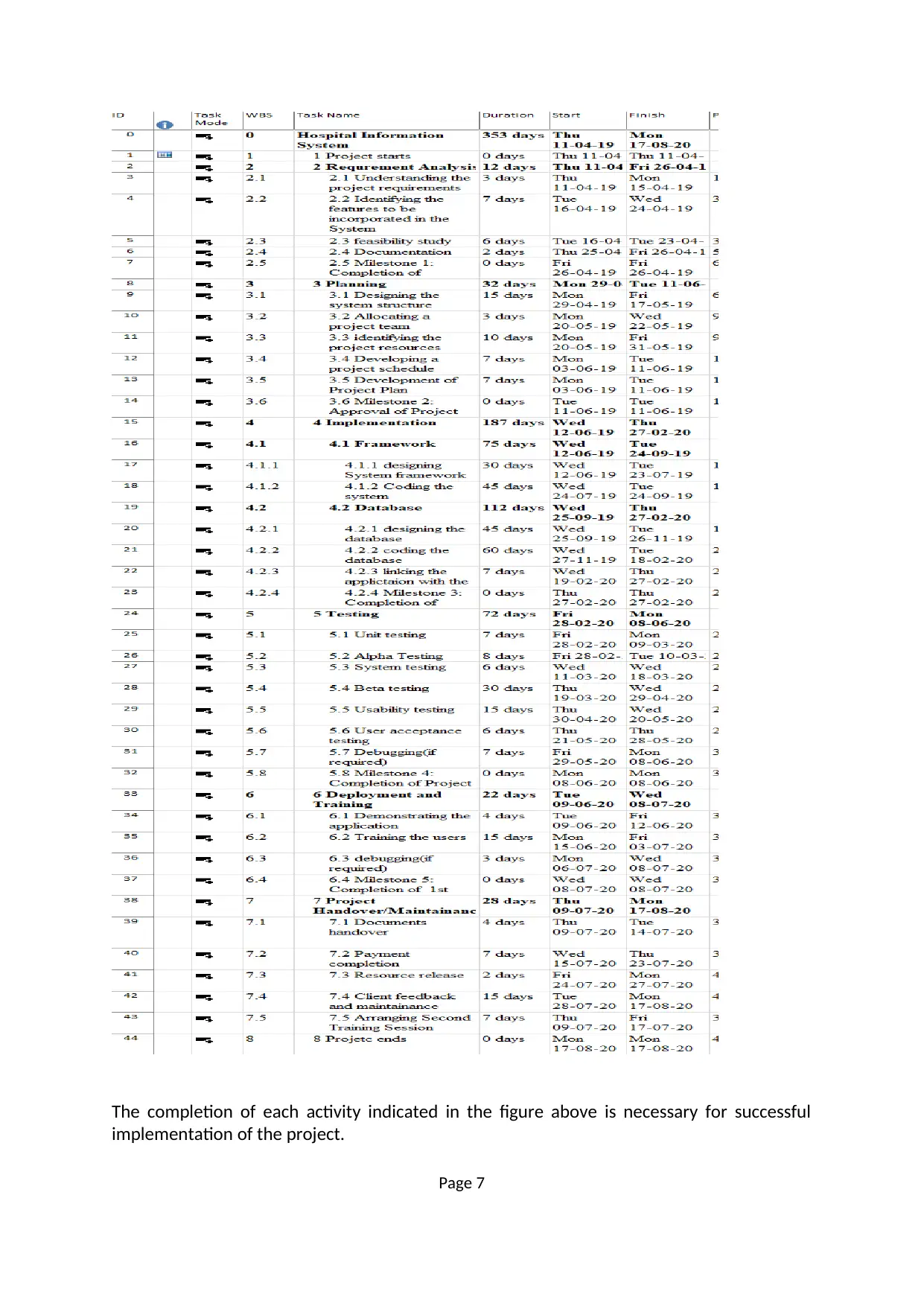
The completion of each activity indicated in the figure above is necessary for successful
implementation of the project.
Page 7
implementation of the project.
Page 7
⊘ This is a preview!⊘
Do you want full access?
Subscribe today to unlock all pages.

Trusted by 1+ million students worldwide

The figure below indicates the Gantt chart generated as per the scheduling activities in the
project.
Page 8
project.
Page 8
Paraphrase This Document
Need a fresh take? Get an instant paraphrase of this document with our AI Paraphraser
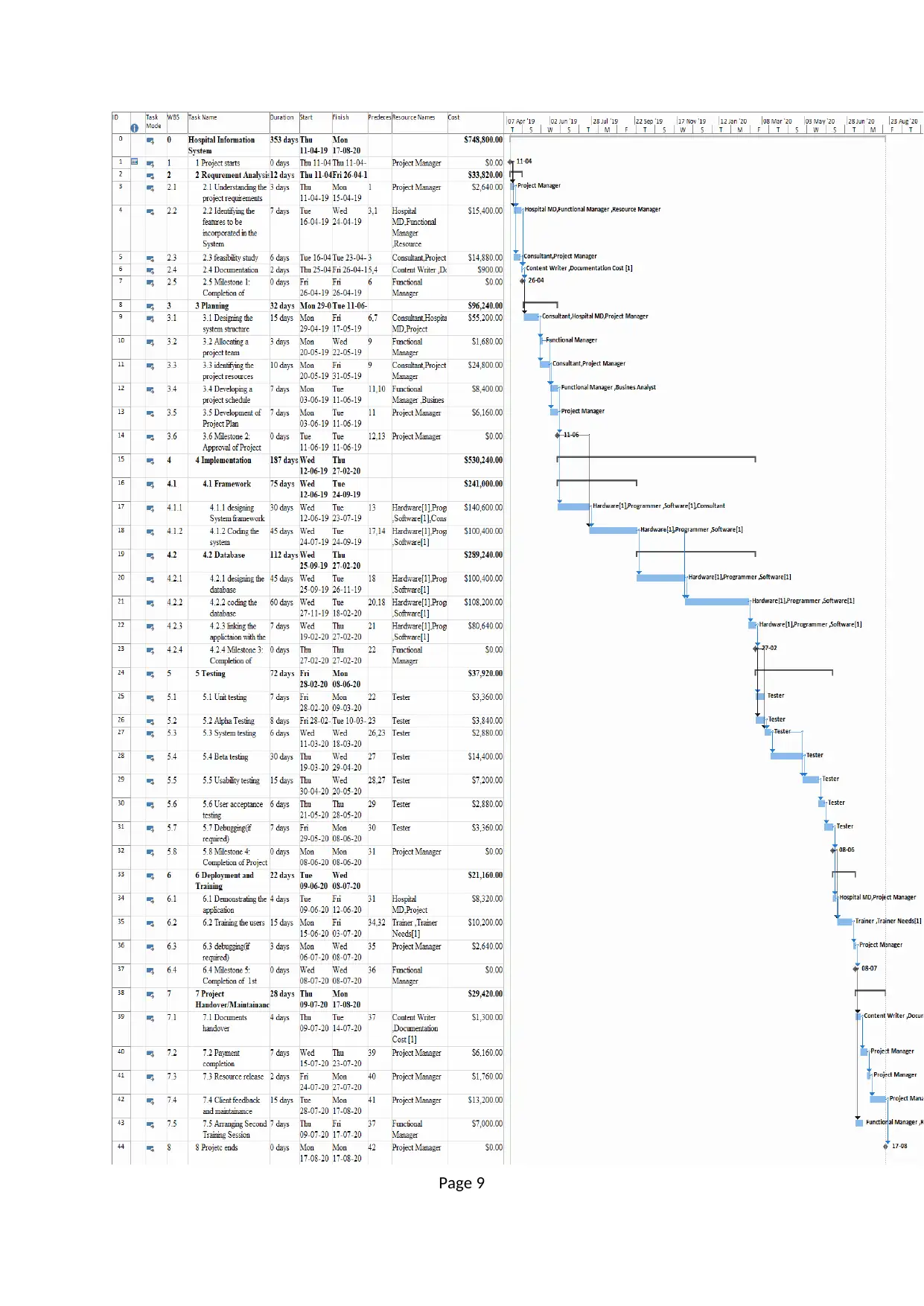
Page 9
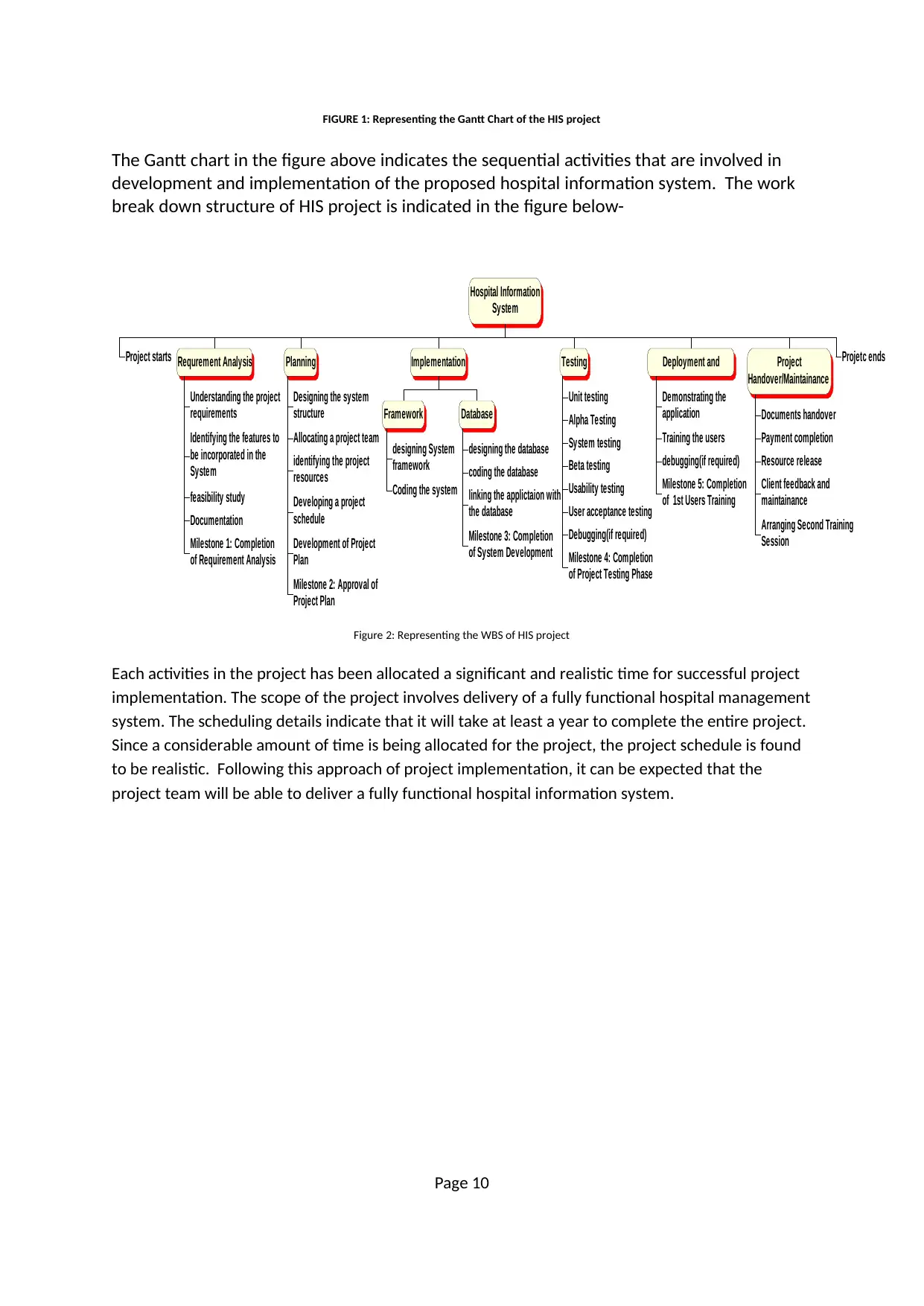
FIGURE 1: Representing the Gantt Chart of the HIS project
The Gantt chart in the figure above indicates the sequential activities that are involved in
development and implementation of the proposed hospital information system. The work
break down structure of HIS project is indicated in the figure below-
Hospital Information
System
Project starts Requrement Analysis
Understanding the project
requirements
Identifying the features to
be incorporated in the
System
feasibility study
Documentation
Milestone 1: Completion
of Requirement Analysis
Planning
Designing the system
structure
Allocating a project team
identifying the project
resources
Developing a project
schedule
Development of Project
Plan
Milestone 2: Approval of
Project Plan
Implementation
Framework
designing System
framework
Coding the system
Database
designing the database
coding the database
linking the applictaion with
the database
Milestone 3: Completion
of System Development
Testing
Unit testing
Alpha Testing
System testing
Beta testing
Usability testing
User acceptance testing
Debugging(if required)
Milestone 4: Completion
of Project Testing Phase
Deployment and
Training
Demonstrating the
application
Training the users
debugging(if required)
Milestone 5: Completion
of 1st Users Training
Project
Handover/Maintainance
Documents handover
Payment completion
Resource release
Client feedback and
maintainance
Arranging Second Training
Session
Projetc ends
Figure 2: Representing the WBS of HIS project
Each activities in the project has been allocated a significant and realistic time for successful project
implementation. The scope of the project involves delivery of a fully functional hospital management
system. The scheduling details indicate that it will take at least a year to complete the entire project.
Since a considerable amount of time is being allocated for the project, the project schedule is found
to be realistic. Following this approach of project implementation, it can be expected that the
project team will be able to deliver a fully functional hospital information system.
Page 10
The Gantt chart in the figure above indicates the sequential activities that are involved in
development and implementation of the proposed hospital information system. The work
break down structure of HIS project is indicated in the figure below-
Hospital Information
System
Project starts Requrement Analysis
Understanding the project
requirements
Identifying the features to
be incorporated in the
System
feasibility study
Documentation
Milestone 1: Completion
of Requirement Analysis
Planning
Designing the system
structure
Allocating a project team
identifying the project
resources
Developing a project
schedule
Development of Project
Plan
Milestone 2: Approval of
Project Plan
Implementation
Framework
designing System
framework
Coding the system
Database
designing the database
coding the database
linking the applictaion with
the database
Milestone 3: Completion
of System Development
Testing
Unit testing
Alpha Testing
System testing
Beta testing
Usability testing
User acceptance testing
Debugging(if required)
Milestone 4: Completion
of Project Testing Phase
Deployment and
Training
Demonstrating the
application
Training the users
debugging(if required)
Milestone 5: Completion
of 1st Users Training
Project
Handover/Maintainance
Documents handover
Payment completion
Resource release
Client feedback and
maintainance
Arranging Second Training
Session
Projetc ends
Figure 2: Representing the WBS of HIS project
Each activities in the project has been allocated a significant and realistic time for successful project
implementation. The scope of the project involves delivery of a fully functional hospital management
system. The scheduling details indicate that it will take at least a year to complete the entire project.
Since a considerable amount of time is being allocated for the project, the project schedule is found
to be realistic. Following this approach of project implementation, it can be expected that the
project team will be able to deliver a fully functional hospital information system.
Page 10
⊘ This is a preview!⊘
Do you want full access?
Subscribe today to unlock all pages.

Trusted by 1+ million students worldwide
1 out of 15
Related Documents
Your All-in-One AI-Powered Toolkit for Academic Success.
+13062052269
info@desklib.com
Available 24*7 on WhatsApp / Email
![[object Object]](/_next/static/media/star-bottom.7253800d.svg)
Unlock your academic potential
Copyright © 2020–2025 A2Z Services. All Rights Reserved. Developed and managed by ZUCOL.




